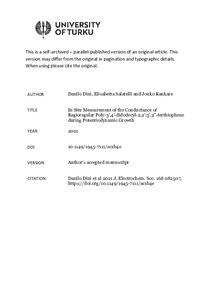In Situ Measurement of the Conductance of Regioregular Poly-3 ',4 '-didodecyl-2,2 ':5 ',2 ''-terthiophene during Potentiodynamic Growth
Dini Danilo; Salatelli Elisabetta; Kankare Jouko
In Situ Measurement of the Conductance of Regioregular Poly-3 ',4 '-didodecyl-2,2 ':5 ',2 ''-terthiophene during Potentiodynamic Growth
Dini Danilo
Salatelli Elisabetta
Kankare Jouko
ELECTROCHEMICAL SOC INC
Julkaisun pysyvä osoite on:
https://urn.fi/URN:NBN:fi-fe2021093048305
https://urn.fi/URN:NBN:fi-fe2021093048305
Tiivistelmä
This work reports a study of regioregular poly-3 ',4 '-didodecyl-2,2 ':5 ',2 ''-terthiophene (poly-3 ' 4 '-DDTT) deposited electrochemically onto a double-band electrode for the in situ measurement of the electrical conductance. The electrodeposition of poly-3 ' 4 '-DDTT was conducted in the potentiodynamic mode within the applied potential interval 0 <= E (appl) <= 0.9 V vs Ag/Ag+ employing an electrolyte that contained the terthiophenic monomer 3 ' 4 '-DDTT (the starting redox species). These electrochemical conditions warrant the oxidation of 3 ' 4 '-DDTT (initiation step) and prevent the oxidative degradation of the polymerization product(s). Through the adoption of conformal mapping we could calculate the electrical conductivity of the electrodeposited polymer thanks to the observation of a linear variation of conductance with the consumed charge of polymerization. The use of conformal mapping has allowed also the determination of the volume yield for the poly-3 ' 4 '-DDTT under consideration. The electrical conductivity of poly-3 ' 4 '-DDTT depended nonlinearly on the scan rate of electrodeposition and varied in the broad range 12 - 34 S cm(-1). The variability of poly-3 ' 4 '-DDTT conductivity depended on the nature of the electrodeposit which, in turn, depended on the rate of oxidative coupling (determined by the electrical current) and on the rate of precipitation (determined by the conditions of saturation in proximity of the double-band electrode).
Kokoelmat
- Rinnakkaistallenteet [27094]
